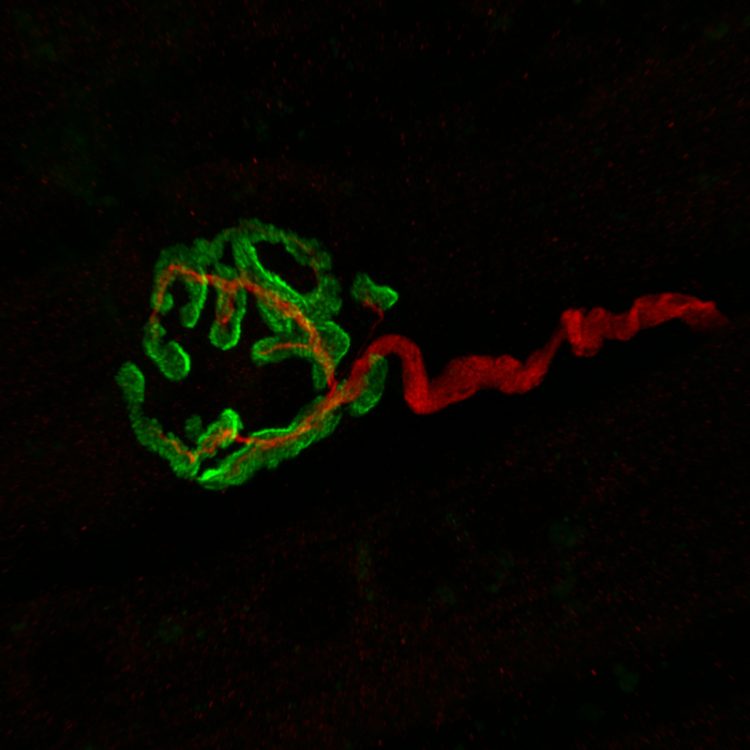Sport makes muscles and nerves fit

Neuromuscular junction: The motor neuron (red) is connected to the synaptic endplate on the muscle fiber (green). Illustration: University of Basel, Biozentrum
This link has been discovered by a research group at the Biozentrum of the University of Basel. The group was also able to induce the same effect through raising the protein concentration of PGC1α in the muscle. Their findings, which are also interesting in regard to muscle and nerve disorders such as muscle wasting and ALS, have been published in the current issue of the journal Nature Communications.
It’s springtime – the start signal for all joggers. It is well known that a regular run through the forest makes your muscles fit. Responsible for this effect is the protein PGC1α, which plays a central role in the adaptation of muscles to training. The research team led by Prof. Christoph Handschin has discovered that such endurance training not only affects the condition of the muscles but also the upstream synaptic neuronal connections in a muscle-dependent manner.
PGC1α does not only make muscles fit
How do muscles change during muscle training or in muscle disease? Christoph Handschin and his team have been addressing this question for some years. In the past, they have already shown that the protein PGC1α plays a key role in the adaptation of the muscle by regulating the genes that cause the muscles to change accordingly to meet the more demanding requirements. When muscle is inactive or ill, only a low concentration of PGC1α is present. However, when the muscle is challenged, the PGC1α level increases. Through artificial elevation of the PGC1α concentration, it is possible to stimulate muscle endurance.
… but also the nerve connections
Now, the scientists have been able to demonstrate that the increase in muscle PGC1α concentration also improves the upstream synaptic nerve connections to the result of this feedback from muscle to the motor neuron: The health of the synapse improves and its activation pattern adapts to meet the requirements of the muscle. Until now, the influence of the muscle on the synaptic connection was primarily recognized in embryonic development. “That in adults, where the nerve and muscular systems are fully developed, not only the muscle changes due to an increase in PGC1α concentration but also a muscle-controlled improvement in the entire nerve and muscular system takes place, was completely unexpected and a great surprise to us”, says Handschin. “Our current aim is to identify the exact signal that leads to this stabilization of the synaptic connections, in order to apply this for treating muscle disorders.”
… and helps in the treatment of muscle and nerve disorders
A direct therapeutic application of the research findings in illnesses such as muscle wasting and amyotrophic lateral sclerosis (ALS) is already conceivable for Christoph Handschin. “In patients, whose muscles due to their illness are too weak to move on their own, an increase in PGC1α levels could strengthen muscles and nerves until the patients can move enough to finally do some physical therapy and to further improve their mobility”, he explains. After the pharmacological improvement of the health status of the muscles and nerves, the patient could independently continue their treatment through practicing endurance sports.
Original Citation
Anne-Sophie Arnold, Jonathan Gill, Martine Christe, Rocío Ruiz, Shawn McGuirk, Julie St-Pierre, Lucía Tabares & Christoph Handschin
Morphological and functional remodelling of the neuromuscular junction by skeletal muscle PGC-1α
Nature Communications, published 1 April 2014 | doi:10.1038/ncomms4569
Further Information
Prof. Christoph Handschin, University of Basel, Biozentrum, phone +41 61 267 23 78, email: christoph.handschin@unibas.ch
http://dx.doi.org/10.1038/ncomms4569 – Abstract
http://www.biozentrum.unibas.ch/research/groups-platforms/overview/unit/handschi… – Research Group Prof. Christoph Handschin >
Media Contact
All latest news from the category: Life Sciences and Chemistry
Articles and reports from the Life Sciences and chemistry area deal with applied and basic research into modern biology, chemistry and human medicine.
Valuable information can be found on a range of life sciences fields including bacteriology, biochemistry, bionics, bioinformatics, biophysics, biotechnology, genetics, geobotany, human biology, marine biology, microbiology, molecular biology, cellular biology, zoology, bioinorganic chemistry, microchemistry and environmental chemistry.
Newest articles

Bringing bio-inspired robots to life
Nebraska researcher Eric Markvicka gets NSF CAREER Award to pursue manufacture of novel materials for soft robotics and stretchable electronics. Engineers are increasingly eager to develop robots that mimic the…

Bella moths use poison to attract mates
Scientists are closer to finding out how. Pyrrolizidine alkaloids are as bitter and toxic as they are hard to pronounce. They’re produced by several different types of plants and are…

AI tool creates ‘synthetic’ images of cells
…for enhanced microscopy analysis. Observing individual cells through microscopes can reveal a range of important cell biological phenomena that frequently play a role in human diseases, but the process of…





















